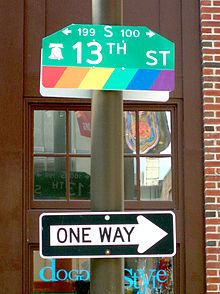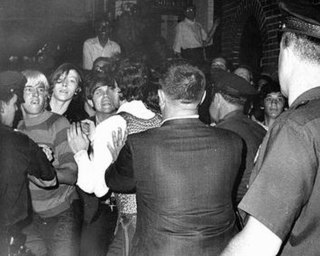
The Stonewall riots were a series of spontaneous protests by members of the gay community in response to a police raid that began in the early morning hours of June 28, 1969, at the Stonewall Inn in the Greenwich Village neighborhood of Lower Manhattan in New York City. Patrons of the Stonewall, other Village lesbian and gay bars, and neighborhood street people fought back when the police became violent. The riots are widely considered the watershed event that transformed the gay liberation movement and the twentieth-century fight for LGBT rights in the United States.
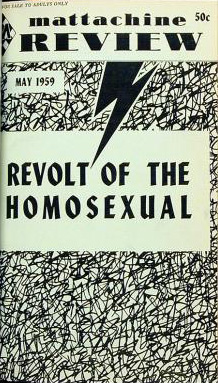
The Mattachine Society, founded in 1950, was an early national gay rights organization in the United States, preceded by several covert and open organizations, such as Chicago's Society for Human Rights. Communist and labor activist Harry Hay formed the group with a collection of male friends in Los Angeles to protect and improve the rights of gay men. Branches formed in other cities, and by 1961 the Society had splintered into regional groups.

A gay village is a geographical area with generally recognized boundaries that is inhabited or frequented by many lesbian, gay, bisexual, transgender, and queer (LGBT) people. Gay villages often contain a number of gay-oriented establishments, such as gay bars and pubs, nightclubs, bathhouses, restaurants, boutiques, and bookstores.

The homophile movement is a collective term for the main organisations and publications supporting and representing sexual minorities in the 1950s to 1960s around the world. The name comes from the term homophile, which was commonly used by these organisations. At least some of these organisations are considered to have been more cautious than both earlier and later LGBT organisations; in the US, the nationwide coalition of homophile groups disbanded after older members clashed with younger members who had become more radical after the Stonewall riots of 1969.

A sit-in or sit-down is a form of direct action that involves one or more people occupying an area for a protest, often to promote political, social, or economic change. The protestors gather conspicuously in a space or building, refusing to move unless their demands are met. The often clearly visible demonstrations are intended to spread awareness among the public, or disrupt the goings-on of the protested organisation. Lunch counter sit-ins were a nonviolent form of protest used to oppose segregation during the civil rights movement, and often provoked heckling and violence from those opposed to their message.
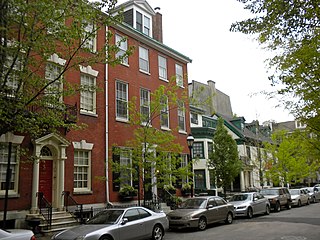
Washington Square West is a neighborhood in Center City Philadelphia, Pennsylvania. The neighborhood roughly corresponds to the area between 7th and Broad Streets and between Chestnut and South Streets, bordering on the Independence Mall tourist area directly northeast, Market East to the north, Old City and Society Hill to the East, Bella Vista directly south, Hawthorne to the southwest, and mid-town Philadelphia and Rittenhouse Square to the west. In addition to being a desirable residential community, it is considered a hip, trendy neighborhood that offers a diverse array of shops, restaurants, and coffee houses. Washington Square West contains many gay-friendly establishments and hosts annual events celebrating LGBT culture in Philadelphia including OutFest. The area takes its name from Washington Square, a historic urban park in the northeastern corner of the neighborhood.

Kiyoshi Kuromiya was a Japanese-American author and civil rights, anti-war, gay liberation, and HIV/AIDS activist. Born in Wyoming at the World War II–era Japanese American internment camp known as Heart Mountain, Kuromiya became an aide to Martin Luther King Jr. and a prominent opponent of the Vietnam War during the 1960s.
This is a list of notable events in the history of LGBT rights that took place in the 1960s.
The Annual Reminders were a series of early pickets organized by gay organizations, held yearly from 1965 through 1969. The Reminder took place each July 4 at Independence Hall in Philadelphia and were among the earliest LGBT demonstrations in the United States. The events were designed to inform and remind the American people that gay people did not enjoy basic civil rights protections.
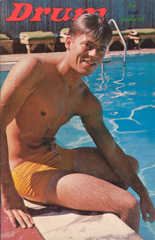
Drum was an American gay men's culture and news magazine published monthly in Philadelphia, Pennsylvania, featuring homoerotic photographs as well as news, book reviews, editorials, and fiction. It was published beginning in October 1964 by the homophile activist group the Janus Society as a continuation of the group's monthly newsletter. Edited by Clark Polak, the president of the Janus Society, the magazine represented Polak's radical approach to the homophile movement by emphasizing sexual liberation when other homophile organizations were focused on assimilating with straight society.
Clark Philip Polak was an American businessman, publisher, journalist, and LGBT activist.
The Janus Society was an early homophile organization founded in 1962 and based in Philadelphia. It is notable as the publisher of Drum magazine, one of the earliest gay publications in the United States and the one most widely circulated in the 1960s, and for its role in organizing many of the nation's earliest LGBT rights demonstrations. The Janus Society takes its name from the Roman two-faced God Janus of beginnings, endings, and doorways. The organization focused on a policy of militant respectability, a strategy demanding respect by showing the public gay individuals conforming to hetero-normative standards of dress at protests.
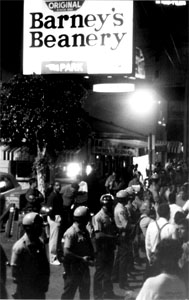
A zap is a form of political direct action that came into use in the 1970s in the United States. Popularized by the early gay liberation group Gay Activists Alliance, a zap was a raucous public demonstration designed to embarrass a public figure or celebrity while calling the attention of both gays and straights to issues of gay rights.

The development of LGBT culture in Philadelphia can be traced back to the early 20th century. It exists in current times as a dynamic, diverse, and philanthropically active culture with establishments and events held to promote LGBT culture and rights in Philadelphia and beyond.
East Coast Homophile Organizations (ECHO) was established in January 1962 in Philadelphia, to facilitate cooperation between homophile organizations and outside administrations. Its formative membership included the Mattachine Society chapters in New York and Washington D.C., the Daughters of Bilitis chapter in New York, and the Janus Society in Philadelphia, which met monthly. Philadelphia was chosen to be the host city, due to its central location among all involved parties.

Stonewall National Monument is a 7.7-acre (3.1 ha) U.S. national monument in the West Village neighborhood of Greenwich Village in Lower Manhattan, New York City. The designated area includes the Stonewall Inn, the 0.19-acre (0.077 ha) Christopher Park, and nearby streets including Christopher Street, the site of the Stonewall riots of June 28, 1969, widely regarded as the start of the modern LGBT rights movement in the United States.
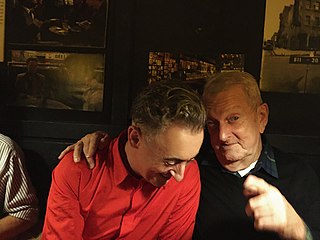
Richard Joseph Leitsch, also known as Richard Valentine Leitsch and more commonly Dick Leitsch, was an American LGBT rights activist. He was president of gay rights group the Mattachine Society in the 1960s. He conceptualized and led the "Sip-In" at Julius' Bar, one of the earliest acts of gay civil disobedience in the United States, LGBT activists used "sip-ins" to attempt to gain the legal right to drink in bars in New York. He was also known for being the first gay reporter to publish an account of the Stonewall Riots and the first person to interview Bette Midler in print media.
On August 5, 1969, the Atlanta Police Department led a police raid on a screening of the film Lonesome Cowboys at a movie theater in Atlanta, Georgia, United States. The raid targeted members of the city's LGBT community, and the aftermath of the raid let to the creation of the Georgia Gay Liberation Front and an increased push for gay liberation in the area. The event has been compared to the Stonewall riots, which occurred a little over a month before the raid. Atlanta Pride, one of the largest pride parades in the United States, was started in part as a response to the raid.
